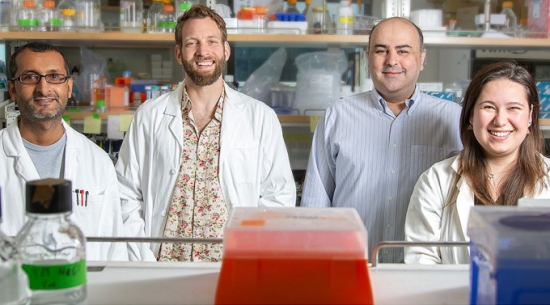RESEARCH NEWS
Antiviral gene known to block HIV also shows potent activity against SARS-CoV-2
By ELLEN GOLDBAUM

UB researchers in the lab are (from left) Uddhav Timilsina, Brandon Waxman, Spyridon Stavrou and Emily Ivey. Photo: Sandra Kicman
June 7, 2022—New UB research reveals valuable information about the ways that host cells work to block entry of SARS-CoV-2 and, in turn, how the virus strikes back.
The findings uncover important features about cellular interactions between virus and host, and how they might be exploited to develop new methods of treatment for both SARS-CoV-2, the virus that causes COVID-19, and HIV.
The research was reported by virologists at the Jacobs School of Medicine and Biomedical Sciences at UB and published May 26 in Nature Communications.
“Viruses and host are in this eternal arms race, in which both try to outwit one another. Understanding more about how that arms race works can only help us in our effort to blunt the effects of both the SARS-CoV-2 and HIV pandemics. ”
Spyridon Stavrou, PhD, Assistant professor, Department of Microbiology and Immunology
Jacobs School of Medicine and Biomedical Sciences
Host cells mount defense
“We are interested in understanding how host cells mount a defense against an invading viral pathogen,” says Spyridon Stavrou, assistant professor of microbiology and immunology in the Jacobs School and corresponding author on the paper.
The team focused on the host gene called Serine Incorporator 5 (SERINC5), which is potently antiviral toward HIV-1, the most prevalent form of the virus. They found that this gene also exhibits potent antiviral activity against SARS-CoV-2 and interestingly, it utilizes the same mechanism to block both SARS-CoV-2 and HIV.
“We were stunned that SERINC5 also blocks SARS-CoV-2, as this factor was primarily known to restrict retroviruses,” says Uddhav Timilsina, a postdoctoral researcher in the Stavrou lab and the first author of the study.
“The most surprising thing we observed is that SERINC5 uses a conserved mechanism to restrict both HIV-1 and SARS-CoV-2, viruses that are quite different and are responsible for current pandemics,” Stavrou says. “This shows a bona fide host-pathogen struggle and emphasizes the importance of SERINC5 as an antiviral gene.”
The UB researchers were also amazed by what they discovered about how the virus responds to SERINC5.
###
Contact
Cory Nealon
cmnealon@buffalo.edu
University at Buffalo
Office of University Communications
330 Crofts Hall, Buffalo NY 14260
Phone: 716-771-9255
Fax: 716-645-3765
http://www.buffalo.edu/news
twitter: @goldbaumkolin
Source: University at Buffalo https://www.buffalo.edu/ubnow/stories/2022/06/hiv-covid-gene.html
"Reproduced with permission - "University at Buffalo"
University at Buffalo
For more HIV and AIDS News visit...
Positively Positive - Living with HIV/AIDS:
HIV/AIDS News |